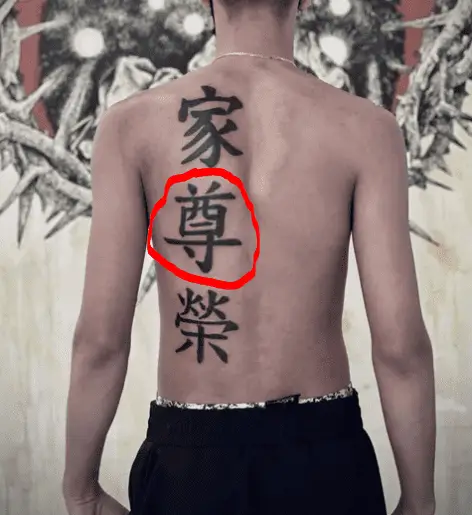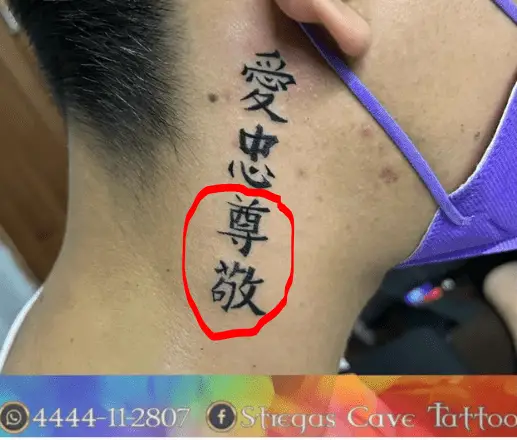
Many people tattoo the word “respect” as a way to express their desire for reverence for themselves or others. The word itself embodies great esteem and establishes social importance, thus, a lot of people want to represent the essence of the word “respect” by marking it in their bodies.
No other culture in the modern era represents best the word “respect” better than the Japanese. The Japanese society is revered as highly respectful and extremely disciplined.
You can understand why many people would be interested in having the Japanese writing for the word “respect” tattooed on their body.
What is the Japanese symbol for respect?
The primary kanji (Chinese characters) for respect used in everyday conversation in the Japanese language is 敬(Kei). The word 敬 is composed of two kanjis: one is 苟 which means “Any”, and the other is 攵 which means “Strike”.
The meaning of this kanji is awe, respect, honor, or revere. This kanji is normally used to refer to the kind of respect that is similar to the English language –one that indicates social importance, high regard, and admiration that warrants good treatment.
What words is the Japanese symbol for respect used in?

The kanji for respect 敬(Kei) is found in many Japanese words including:
- 尊敬 Respect
- 敬語 Honorific Words
- 敬愛 Adoration
- 敬意 Respect, Honor
1. 尊敬 (Sonkei) – Respect
Used both as a noun and verb which generally means respect, honor, esteem, and regard. When you want to refer to the word “respect” we use in English where the difference in social distance is accompanied by proper gestures, you often use this word.
Example Sentences For the Japanese word for 尊敬 (Sonkei):
私たちは両親を尊敬し、愛しているがゆえに、両親に従う。
We obey our parents because we honor them and we love them.
彼は友達皆に尊敬された。
He was looked up to by all his friends.
彼女は先生をとても尊敬している。
She respects her teacher a lot.
2. 敬語 (Keigo) – Honorifics
This refers to the Japanese honorific speech where the level of politeness used in speaking varies based on social stratification. Its meaning is limited to the polite way of speaking with other people. Keigo is less observed among friends and people younger than you where the social status is either the same level or lower than yours.
Honestly speaking, it would be weird to see this word as a tattoo. It’ll be like putting a “Politeness Marker” as a tattoo somewhere in your body.
Example Sentences For the Japanese word for 敬語 (Keigo):
日本語には敬語があります。
The Japanese language has honorific expressions.
最近、目上の人に敬語を使わない若者が多い。
Recently there are a lot of young people who don’t use respectful language to their superiors.
3. 敬愛 (Keiai) – Adoration
“Keiai” literally means respect (敬) and love (愛). This word is often used to refer to the meaning of adoration. One way to use this is when you are referring to your loved ones and family members.
Example Sentences For the Japanese word for 敬愛 (Keiai):
敬愛するおばあちゃんがいなくて寂しい。
We miss our dear grandmother.
彼の家族は彼のことを敬愛していた。そしてある意味で彼は彼らに甘やかされていた。
His family adored him and, in a sense, he was spoiled by them.
4. 敬意 (Keii) – Respect, Honor
This word refers to one’s honor. Its dictionary meaning is respect, reverence, and honor. It is often used to refer to the kind of respect one would get through achievements. It is a very formal type of respect.
Example Sentences For the Japanese word for 敬意 (Keii):
市はその将軍に敬意を表して記念碑を捧げた。
The city dedicated a monument in honor of the general.
勇者に敬意を払いなさい。
Pay honor to the brave.
彼らはその著名な科学者に敬意を表して宴会を催した。
They held a party in honor of the famous scientist.
Another character that can mean respect in Japanese
Another commonly used kanji for respect is 礼 read as “Rei”. This kanji is different from 敬 since 礼 refers more to the ceremonial, ritual, and social gestures of showing respect to other people, particularly those whom you look up to or those who are important to you such as your teachers, work boss, your fellow group members, and leaders.
“Rei” is mostly used in Martial Arts, particularly in Bushido (the moral code of the Samurai). The literal meaning of “Rei” are thanks, gratitude, manners, etiquette, bow, reward, gift, ceremony, and ritual.
Many foreigners are confused about whether to refer to 敬 or 礼. You need to remember that 敬 (Kei) is a general type of respect you would give to another person who has higher status –something you feel more than anything else– while 礼 is the gesture you would show to people you want to avoid losing face.
Both 敬and 礼 are not exclusive to one another especially since ceremonial gestures of politeness are part of the entirety of giving respect.
A common word that uses 礼 is:
礼儀 reigi Manners
Is the Japanese symbol for “respect” the same in Chinese?
The symbol 敬 in Japanese has the same meaning in Chinese. Both languages use 敬 to refer to the word “respect” that we use in English.
In Chinese, 敬 is pronounced as “Jìng” –read very differently in the Japanese language.
On the other hand, 礼 in Chinese is a simplified version of the kanji 禮. While the Japanese version focuses more on gestures used to show great respect such as bowing, showing gratitude, etc., the Chinese counterpart’s meaning is more about the actions done in ceremonial rituals.
How to write the Japanese character for “Respect”
There are 12 strokes for the kanji 敬(Kei) and it starts from the upper left goes down to the lower left and then starts again at the upper right all the way to the lower right.
While the kanji for 礼 has 5 strokes and the order of stroke is as follows:
Remember that stroke direction when writing kanji is from left to right and up to down.
Historical versions of the Japanese symbol for respect
The origin of the kanji 敬(Kei) dates back in the Zhou Dynasty in China.
On the other hand, the glyph origin for the kanji for 礼(Rei) was originally found in the Shouwen Jiezi (an ancient dictionary in the Han Dynasty) as which eventually became 禮in the modern era. However, the character 禮was further simplified turning individual radicals 示 into 礻and 豊 into乚, thus, it became 礼in the Japanese language.
What is the Japanese concept of respect?
Japanese culture places a high value on “respect.” This concept is integral to Japanese society and is used to govern interactions between people. In order to maintain respect, individuals must comply with social norms and expectations. Failure to do so can lead to negative consequences, such as being shunned or discriminated against. Japanese people take pride in their culture and are often reluctant to change or adapt their behavior in order to gain respect from others.
In Japan, respect is seen as a way to maintain harmony and social order. It is considered important to show respect for others, no matter what their position or status may be. There are many different ways to show respect in Japan, and it can vary from situation to situation. For example, you might bow when meeting someone of high rank, or offer your seat on public transportation to someone older than you.
Is the Chinese character for “respect” a popular tattoo?
The Chinese characters for respect are one of the most popular tattoos, especially the kanji 礼 (Rei) which is often associated with the Samurai culture. Most people who like this tattoo want to be or are associated with the practice of martial arts because of its background in the Japanese language and culture.
Should you get “respect” done as a tattoo in Japanese writing?

This is a tattoo that you could definitely consider. As always, you’d want to make sure you are doing it right.
Find out the type of respect you want to be tattooed on your body, whether it’s an adoration type of respect, respect related to achievements and honor, respect associated with being a warrior, or just something you would give to one another.
It’s very important to know your Kanji and it’s more important to know the real meaning of your tattoos.
Other popular Japanese symbols for people that are interested in the idea of “Respect” include the Japanese symbol for “faith”.
